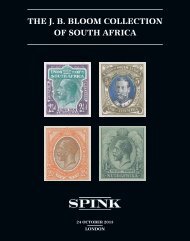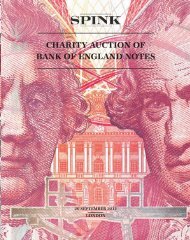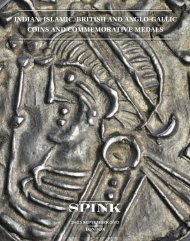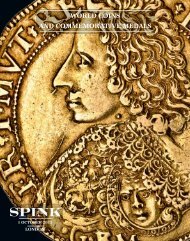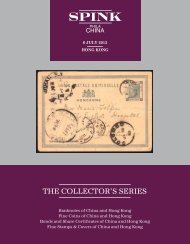Download PDF - Spink
Download PDF - Spink
Download PDF - Spink
- No tags were found...
Create successful ePaper yourself
Turn your PDF publications into a flip-book with our unique Google optimized e-Paper software.
Dec 05 Editorial 29/11/05 4:27 pm Page 370W J D and the N S M W T WLaurence BrownThe laudatory medal of William John Davis (1848-1934),eminent trades unionist and noted numismatist, was one of themany medals listed by Colonel M. H. Grant in an addenda to hisCatalogue of British Medals Since 1760, (BNJ vol.XXIII, 1940-41,p. 478). It is also described in detail in British Historical Medals,1760-1960, vol. III No. 3869 (gilt copper) wherein it is noted thatthe author had been unable to decide on what occasion the piecehad been issued, but presumably on behalf of the AmalgamatedMetal Wire and Tube Makers, of whom no record had been found.The illustration at the head of this present note is of a specimen ofthe medal in white metal in the author’s possession.Recent research at the Trades Union Congress library has shedmore light on the subject. The correct name of the Union appearsto have been The National Society of Metal Wire and TubeWorkers and it was, indeed, founded in 1896 as shown on themedal. The Union was established with a membership of 1,500and briefly grew to 1,645 members in 1899 but then fluctuatedwidely over the succeeding years until, in 1949, the membershiptotalled just 100.The authors of the Historical Directory of Trade Unions note‘It appears to have gone out of existence in 1950, there being nonotice given of an amalgamation with any other union 1 .’ Forthe whole of its life the registered head office of the Society was at22 Summer Row, Birmingham.No firm evidence has been discovered among the few survivingdocuments of the Society in the T.U.C. Library as to why the date1902 was chosen for the medal and in the papers examined Davis’name does not feature among the officers of the Society. However,Davis was of considerable importance in the trades unionmovement and served as a member of the parliamentarycommittee from 1896 until 1915 with a break in 1902,apparently caused by his attitude to the Boer War, being ‘opposedto the view that Congress should speak out against the War,opining that it should be carried though to a finish in the interestsof the worker in South Africa 2 ’. In 1902 Davis was chairman ofthe Labour Representation Committee (in 1906 it became theLabour Party) and was in the chair at the LRC Conference atBirmingham in that year 3 .It may have been as a result of his being Chairman at thatconference that the NSMWTW chose to feature Davis soprominently on the obverse of the medal. The effigy of Davis bearsresemblance to a photograph of him reproduced in the BritishNumismatic Journal 2003 Centenary volume, pl.13 (a). This alsoappears in a history of the National Society of Metal Mechanics 4 .Here, the author notes that it is ‘From a photograph by Lafayette’.This can probably be attributed to the photographic studiofounded by James Lafayette which traded as Lafayette Ltd at 178-9 New Bond Street, London, W1, c. 1897-1908The reverse of the medal depicts a winged standing femalefigure, presumably Liberty, holding a staff topped with a Phrygianbonnet, frequently called a cap of Liberty, and an inverted fasces,the latter being a bundle of elm or possibly birch rods enclosing anaxe and bound with red thongs, the emblem of the superiorRoman magistrates. It is also a symbol of unity; but does not,however, appear to have been an attribute of Liberty 5 . Theseemblems carried by the Lictors of Rome were held over theirshoulders with the axe head toward the top of the bundle. Thefasces is also occasionally depicted with other emblems onthe coinage of the Roman Republic and on that issued byC. Norbanus, c. 83 BC, for example, it is shown inverted (Crawford357/1) 6 : perhaps there is some significance in the fact that on theNSMWTW medal Liberty is holding an inverted fasces.P. Valerius Publicola (Consul, 506 and 505 BC, died 504 BC) achampion of popular rights, established the custom that thefasces were to be lowered before the people since Publicolabelieved that their power was superior to that of the Consuls (Livyii,7, Florus i, 9).Even though Davis had apparently lacked a formal education,as a trades unionist and a numismatist of wide interests, it ispossible that he was aware of the importance of this act and ifconsulted by the union on the design of the medal requested thatthe engraver depict in a pictorial form how the power of thepeople should be regarded from henceforth. It seems likely thoughthat the significance of this would have been lost on those tradesunionists who were not as well read as Davis.Alternatively, if Davis had had little to do with the issue of themedal, but simply agreed to his portrait being depicted on theobverse, the reverse design being left to the medallist, the invertedfasces may simply be a happy coincidence. The carelessness in thename of the union is not, however, so fortunate.The medal is signed ‘R’ to the left of Liberty’s staff and itwould not be unreasonable to think that this is the signature ofJ. A. Restall (fl. 1873-1914), a Birmingham jeweller, silversmith,die-sinker and medallist who, among his other medallic work, cutdies for personal new year tokens (Tickets and Passes, 342/9-12,343/19-43) for W. J. Davis and S. H. Hamer 7 .Footnotes:1. Historical Directory of Trades Unions, Arthur Marsh and Victoria Ryanvol. 2. Gower Publishing 1984, p.172.2. The Life Story of W. J. Davis, J.P. The Industrial Problem. Achievements andTriumphs of Conciliation, W. A. Dalley, Birmingham 1914.3. Dictionary of Labour Biography, Ed. Joyce M. Bellamy and John Saville vol.VI, Macmillan, 1992, p.94.4. Founded in Brass, The First hundred Years of the National Society of MetalMechanics, from Chandeliers to Concorde, Malcom Totten, 1972, p.11.5. Dictionary of Subject and Symbols in Art, James Hall, John Murray, revisededn. 1996, p.119.6. Roman Republican Coinage, M. Crawford, Cambridge University Press,1974.7. A Dictionary of Makers of British metallic tickets, checks, medalets, tallies andcounters, 1788-1810, R. N. P. Hawkins, ed. Edward Baldwin, p.424For New Milled Copper and Bronze coinsplease see the latest updates to our websitewww.spink.comAlternatively come and see our extensivestock at our officesMonday to Friday – 9.30 am to 5.30pm370 NUMISMATIC CIRCULAR



